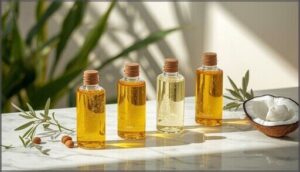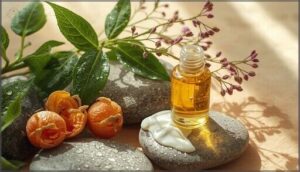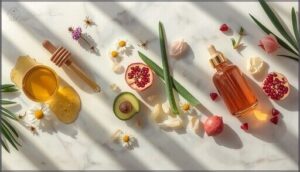This site is supported by our readers. We may earn a commission, at no cost to you, if you purchase through links.
Your bathroom cabinet holds a paradox. Products labeled “natural” sit next to synthetic formulas, both promising healthier skin. But natural doesn’t automatically mean safe. Some plant extracts trigger allergic reactions while certain lab-made compounds work gently on sensitive skin.
The distinction between natural and synthetic matters less than how ingredients interact with your skin’s biology. Understanding safe natural ingredients for skin requires looking beyond marketing claims. You need to evaluate ingredient sourcing, concentration levels, and clinical evidence.
Your skin deserves ingredients backed by science, not just appealing labels. Smart choices start with knowing which natural components actually deliver results without causing harm.
Table Of Contents
- Key Takeaways
- What Makes a Skin Ingredient Safe and Natural?
- Top Science-Backed Natural Ingredients for Skin
- Natural Ingredients for Different Skin Types
- Evaluating The Safety and Effectiveness of Natural Ingredients
- Market Trends and Consumer Tips for Safer Choices
- Frequently Asked Questions (FAQs)
- Conclusion
Key Takeaways
- Natural doesn’t guarantee safety—many plant extracts trigger allergic reactions while some lab-made compounds work gently, so you need to evaluate ingredients based on clinical evidence rather than marketing labels.
- Science-backed natural ingredients like hyaluronic acid, bakuchiol, and green tea extract deliver measurable results when used at proper concentrations, with studies showing improvements ranging from 25% to 134% in hydration, wrinkle reduction, and oxidative stress.
- Your skin type determines which natural ingredients work best—dry skin needs moisture-locking shea butter and hyaluronic acid, sensitive skin requires calming oat and chamomile, while aging skin benefits from bakuchiol and vitamin C derivatives.
- Over 94% of “natural” products contain at least one known allergen, so you should patch test new ingredients, introduce one product at a time, and check ingredient databases like EWG Skin Deep before trusting any “natural” label.
What Makes a Skin Ingredient Safe and Natural?
You can’t judge a skincare ingredient by its label alone. The term “natural” gets thrown around without much oversight, and that can create confusion about what’s actually safe and effective.
Let’s break down what truly matters when you’re evaluating ingredients for your skin.
Definitions: Natural Vs. Synthetic Ingredients
When you’re choosing skincare, understanding ingredient origins matters. Natural ingredients come from plants, minerals, or animal sources with minimal processing. Think jojoba oil or aloe vera. Synthetic ingredients are lab-made or chemically modified compounds like retinoids.
Here’s what sets them apart:
- Source: Natural uses botanical extracts; synthetic relies on chemical engineering
- Processing methods: Natural ingredients stay minimally altered; synthetics undergo extensive modification
- Safety perceptions: Over 57% of US women prioritize natural options, though scientific consensus shows both types require proper testing for ingredient efficacy and safety
Despite popular belief, “natural” doesn’t guarantee safer cosmetic ingredients—regulatory definitions remain inconsistent. Some prefer natural options to avoid potential synthetic skincare ingredients.
Regulatory Standards and Certifications (e.g., EWG Verified)
To verify your products meet safety benchmarks, look for trusted certifications. EWG Verification requires full ingredient disclosure—even fragrances—and bans harmful substances like parabens and phthalates. COSMOS Standard mandates 95% natural ingredients, while NATRUE Certification requires controlled organic sourcing. FDA Regulations now demand facility registration and safety documentation. GMP Compliance ensures quality control. EWG Verified products undergo rigorous evaluation.
Here’s how they compare:
| Certification | Key Requirement | Focus Area |
|---|---|---|
| EWG Verified | Full transparency | Ingredient safety |
| COSMOS Standard | 95% natural content | Composition standards |
| NATRUE Certification | Organic sourcing | Supply chain ethics |
These regulatory databases help you find safer personal care products backed by verified standards.
Importance of Ingredient Transparency and Sourcing
Beyond certifications, you need to know where your ingredients come from. Ethical sourcing and full supply chain transparency build consumer trust. When brands openly share ingredient origins, you can evaluate ingredient safety through science-backed toxicology data.
This brand accountability matters—71% of consumers pay more for transparent sourcing. Yet regulatory challenges persist: 30% of natural ingredients lack sufficient safety data, making ingredient evaluation critical for your skin’s protection.
Common Misconceptions About “Natural” Labels
The label “natural” doesn’t guarantee safety. It lacks a regulatory definition, allowing brands to use it freely without consistent standards. Greenwashing tactics are prevalent, with companies highlighting one botanical ingredient while hiding synthetic preservatives.
Natural doesn’t guarantee safety—brands exploit the unregulated label to greenwash products while hiding synthetic ingredients behind botanical marketing
Essential oils and plant extracts can irritate the skin, despite their natural origins. Even science-backed natural ingredients vary in safety based on concentration and formulation.
Only 9% of Americans trust these voluntary labels. Sciencewashing in cosmetics further complicates certification and ingredient safety evaluation.
Top Science-Backed Natural Ingredients for Skin
You want ingredients that work and won’t harm your skin. The good news is that research backs several natural options that deliver real results.
Here’s what the science says about the most effective natural ingredients you can trust.
Hydrating Agents: Aloe Vera, Hyaluronic Acid, Glycerin
When your skin needs a moisture boost, three natural ingredients stand out. Hyaluronic acid holds up to 1,000 times its weight in water. Aloe vera extract reduces water loss and strengthens your skin’s barrier. Glycerin, a humectant found in 79% of dermatologist-recommended hydration products, is another key player.
Together with ceramides, these ingredients improve skin hydration for up to 24 hours.
Nourishing Oils: Jojoba, Argan, Squalane, Coconut
Your skin thrives when you feed it the right oils. Squalane boosted cell turnover by 53% compared to argan and is non-comedogenic. Jojoba improved softness by 37% in three weeks. Coconut oil reduced protein loss by 68% while increasing lipid levels by 42%. Argan enhanced elasticity by 26%.
These natural skin care ingredients offer lipid profile benefits and support skin barrier repair through enhanced oil absorption rates.
Botanical Antioxidants: Green Tea, Rose Hip Oil, Bakuchiol
Free radicals age your skin faster. Green tea extract cuts oxidative stress from photodamage by 30% in eight weeks. Rose hip oil improved pigmentation and elasticity by 25%. Bakuchiol’s photostability lets you use it daily—it matched 70% of retinol’s collagen boost with far less irritation.
These antioxidant-rich natural ingredients deliver real results through proven mechanisms.
Soothing Extracts: Chamomile, Calendula, Rosewater
Your skin throws a fit when irritated—that’s where chamomile, calendula, and organic rosewater step in. These anti-inflammatory, science-backed natural ingredients deliver real soothing power for reactive skin.
Chamomile’s bisabolol dropped dermatological irritation by 60% in controlled studies. Calendula improved wound healing rates by 75% while supporting collagen production. Rosewater cut self-reported irritation by 46% in four weeks.
Natural Ingredients for Different Skin Types
Your skin type determines which natural ingredients work best for you. Dry skin needs different support than sensitive or aging skin. Here’s what the research shows for each skin type.
Ingredients for Dry Skin: Shea Butter, Hyaluronic Acid
Dry skin needs two kinds of help: ingredients that pull water in and others that lock it in. Hyaluronic acid draws moisture to your skin and can boost hydration by up to 134% right after you apply it. Shea butter seals that moisture in with fatty acids that form a protective barrier.
Use hyaluronic acid first, then layer shea butter on top for the best results.
Sensitive Skin Solutions: Oat, Aloe Vera, Chamomile
When your skin reacts to everything, you need ingredients that calm instead of provoke. Oat extract improves all signs of sensitive skin with zero adverse reactions in clinical studies.
Aloe Vera hydrates while reducing inflammation through natural polysaccharides. Chamomile’s bisabolol compound addresses redness and swelling in conditions like eczema and rosacea.
These natural ingredients work gently but effectively for skin irritation.
Anti-Aging Botanicals: Bakuchiol, Vitamin C Derivatives
Bakuchiol and vitamin C derivatives deliver antiaging skincare results without harsh side effects. In a 12-week trial, bakuchiol matched retinol’s wrinkle reduction and hyperpigmentation improvement while causing less irritation.
Vitamin C derivatives boost collagen production by 22% and fade sun damage. Their antioxidant benefits protect your skin from daily environmental stress.
These science-backed natural ingredients work together through botanical synergy for visible anti-aging results.
Evaluating The Safety and Effectiveness of Natural Ingredients
Not all natural ingredients work the same way or deliver the same results. You need to know how to check their safety records and understand what the research actually says.
Let’s look at the tools and evidence that help you separate effective ingredients from empty promises.
Understanding Ingredient Ratings and Databases (e.g., EWG Skin Deep)
You can check ingredient safety using databases like EWG Skin Deep, which rates over 88,475 products and 11,500 natural ingredients on a 0–10 hazard scale. Lower scores mean fewer concerns.
The database uses peer-reviewed research to flag issues like allergens or toxicity. Keep in mind, ratings don’t account for individual sensitivities, and some scores reflect missing data rather than proven harm.
Clinical Evidence and Dermatologist Recommendations
Over 500 clinical studies back the safety and efficacy of natural ingredients in skincare. Trials show that 36 out of 45 botanical preparations outperformed synthetic options or placebos.
Dermatologists endorse science-backed ingredients like bakuchiol, aloe vera, and niacinamide because they’ve proven effective in controlled settings.
You’ll want products tested through rigorous safety protocols, not just labeled “natural.
Potential Allergens and Adverse Reactions
Even science-backed natural ingredients can trigger reactions. Over 94% of “natural” products contain at least one known allergen.
Botanical reactions are common—patch testing shows 47.6% of sensitive users react to plant extracts. Essential oils and skin irritation often go hand in hand.
Tea tree oil, fragrances, and propolis top the sensitizer trends list. Watch for skin irritation and redness, especially if you have skin sensitivity.
Importance of Concentration and Formulation
When you think natural equals pure, remember that ideal concentration makes all the difference. Vitamin C proves useless below 8% but irritates above 20%. Clinical variability is real—60% of products fall short on ingredient efficacy.
- Cosmetic formulation and pH affect how well actives absorb into your skin
- Ingredient stability drops 40% within weeks if the formulation matrix isn’t protective
- Safety profiles shift dramatically when natural ingredient benefits exceed proven doses
Science-backed dosing turns botanicals into effective tools.
Market Trends and Consumer Tips for Safer Choices
More people are choosing natural skincare than ever before. You want products that work without exposing your skin to unnecessary chemicals.
Let’s look at what’s driving this shift and how you can make smarter choices when shopping for skincare.
Growth of Natural Skincare and Consumer Preferences
Natural skincare is no longer a niche trend—it’s mainstream. The global market is expected to hit $16 billion by 2035, reflecting widespread consumer priorities for clean beauty and science-backed ingredients.
You’re part of a movement: 59% of shoppers now choose organic skincare benefits for safety and transparency. Demographic trends show Gen Z leads at 73%, driving future growth in skin health and wellness with ethical, ingredient-focused products.
Tips for Building a Safe, Natural Skincare Routine
Before diving into products, identify your skin type—dry, oily, or sensitive—to match natural ingredients to your needs. Up to 74% of dermatology experts recommend this first step for skincare routine tips.
- Start with patch testing: Apply new products to a small area for 48–72 hours to catch reactions early
- Introduce one product at a time: This helps you pinpoint what works and what doesn’t
- Choose science-backed ingredients: Look for aloe vera, jojoba oil, or niacinamide with proven benefits
- Check ingredient sourcing: Transparent brands build trust and deliver safer formulas
- Stay consistent: Daily use of basic steps—cleanse, moisturize, protect—improves skin health in 77% of users
Gradual introduction and routine consistency matter more than buying everything at once. Natural skincare benefits show up when you give your skin time to adapt.
Sustainable and Ethical Ingredient Sourcing
Where do your skincare ingredients come from? Ethical harvesting and supply chain transparency protect biodiversity while supporting fair trade. Look for certifications like COSMOS or UEBT to verify cruelty-free and plant-based ingredients.
Sustainable beauty practices guarantee eco-friendly product options that don’t harm ecosystems. Brands committed to natural ingredients with transparent sourcing create safer choices for your skin and the planet.
Frequently Asked Questions (FAQs)
Can natural ingredients expire or lose potency?
Yes, your natural skincare does expire. Most formulas last three to four months without synthetic preservatives. Potency degradation happens faster when products face heat, light, or air exposure regularly.
How do I patch test new ingredients?
Before trying new skincare, apply a small amount to your inner forearm twice daily for seven to ten days.
Watch for reaction indicators like redness, swelling, or itching—signs you’re sensitive to high-risk allergens.
Are natural preservatives effective against bacteria?
Like a key fitting a lock, natural preservatives can work against bacteria—but formulation challenges and concentration matters affect their efficacy.
Science-backed studies show market growth despite regulatory hurdles around cosmetic ingredients’ antimicrobial power.
Can I mix different natural oils together?
You can mix natural skin care oils together safely by following carrier oil ratios of six drops essential oil per 30 mL carrier.
Patch test first, as oil blend benefits vary with proper dilution.
Do natural ingredients work for acne-prone skin?
Several natural ingredients for oily skin show real promise for acne treatment. Tea tree oil, aloe vera, and green tea extract reduce breakouts effectively.
However, avoid coconut oil and cocoa butter—they’re highly comedogenic and worsen acne-prone skin.
Conclusion
The irony? Your skin doesn’t care whether ingredients come from a lab or a garden. What matters is whether they work safely for your specific needs.
Safe natural ingredients for skin require the same scrutiny as synthetic ones—check concentrations, understand potential reactions, and prioritize clinical evidence over marketing hype.
Your bathroom cabinet should reflect informed decisions, not assumptions. Choose ingredients that your skin biology reacts well to positively, regardless of their origin story.
- https://www.nature.com/articles/d42473-019-00413-z
- https://pmc.ncbi.nlm.nih.gov/articles/PMC11649404/
- https://clini-derma.com/en/dermatologist-approved-natural-skin-care/
- https://www.theingredientsstore.com/blogs/ingredient-insights/natural-ingredients-our-2024-trend-report
- https://www.otsdermatology.com/blog/skincare-ingredients-that-deliver-real-results-according-to-science











